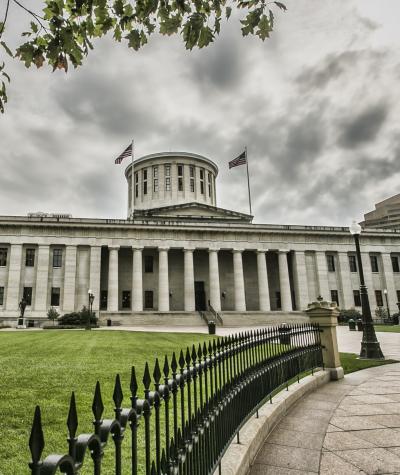The arrest of Ohio Rep. Larry Householder, Speaker of the Ohio House of Representatives, on federal corruption and racketeering charges has rocked Ohio politics.
The underlying scheme leading to his arrest has, unfortunately, provided the people of Ohio a stark illustration of how wealthy special interests can use particular types of organizations to launder money and conceal corruption.
Although the Ohio House voted unanimously to remove Householder as its Speaker, further fixes are needed to stem the tide of dark money in our elections.
At its simplest, the Ohio corruption scandal is a straightforwardly egregious pay-to-play scheme: in exchange for millions of dollars from a power company to aid his ascent to Speaker of the Ohio House—and kickbacks along the way—Householder agreed to pass a billion dollar bailout of the power company’s two nuclear power plants.
At its most complex, the scheme involved several individuals and interconnected entities passing around and spending millions of dollars to influence Ohio politics while obscuring the true source of the funds. At the center of it all was a 501(c)(4) organization called “Generation Now” that Householder allegedly secretly controlled.
According to the U.S. Attorney’s Office for the Southern District of Ohio, here is a basic timeline of the scheme:
In 2017, following Householder’s return to the Ohio House and the power company’s inability to secure a bailout for its two failing nuclear power plants previously, the power company begins making quarterly $250,000 payments to Generation Now.
Throughout 2017 and 2018, over $2.9 million went from the power company and affiliated entities—including a separate “pass-through” 501(c)(4) controlled by the power company—to Generation Now and Generation Now-connected groups.
The money was spent on supporting candidates for the Ohio House that would vote for Householder as Speaker and, ultimately, follow his lead on the nuclear bailout.
In 2019, Householder is elected Speaker, with the vote of every candidate that was supported by Generation Now and introduces the nuclear bailout—House Bill 6—three months later.
After H.B. 6’s introduction, the power company increased its payments to Generation Now—with about $8 million going to Generation Now by May 2019—to buy mailers and media ads to pressure lawmakers to support the bailout. The bill passed the House in May 2019 and was ultimately signed into law in July 2019.
Shortly after H.B. 6 was signed into law, a campaign organized around a statewide ballot-initiative referendum opposing the law was formed, which required collecting enough signatures to get the initiative on the ballot.
Between July 2019 and October 2019, the power company funneled over $38 million to Generation Now to oppose the ballot-initiative campaign, including by purchasing media ads and mailers against the campaign, “conflicting out” signature-collection firms—i.e., hiring those firms to prevent them from being able to work for the campaign because of a conflict of interest—and paying off and bribing signature collectors supporting the campaign.
The campaign ultimately fell short of collecting the necessary number of signatures, securing HB 6’s status as the law of Ohio.
Along the way, the individual members of the scheme, including Householder, also used Generation Now funds for their personal benefit. For example, Householder allegedly used $100,000 to pay costs associated with his Florida home.
As the U.S. Attorney for the Southern District of Ohio explained, the “key” to the success of the scheme was hiding the power company as the source of the millions of dollars being given to Generation Now. In response, Ohioans across the political spectrum have called for reform of Ohio’s campaign finance regime.
House Bill 737 is one proposed legislative response, and Campaign Legal Center (CLC) has analyzed the bill to determine what impact it would have on improving election transparency in Ohio.
While the bill would address some of the most glaring gaps in Ohio’s campaign finance laws, it falls short by leaving significant room for wealthy special interests to hide their influence in Ohio’s elections. Moving forward, meaningful transparency reform that will truly shine a light on sources of big spending in Ohio elections must have at least three features:
First, all big spending in Ohio elections should be covered by disclosure requirements, regardless of the identity or classification of the spender. Current Ohio law focuses on classifying various entities into different categories and setting disclosure requirements based on those categories.
Any meaningful reform must ensure that all spenders above a set threshold are subject to disclosure, preventing the use of particular types of organizations to avoid disclosure.
Second, the law should require the disclosure of the original sources of money for big spending in Ohio elections. Without tracing back spending to original sources, wealthy special interests can avoid disclosure by creating pop-up shell groups.
Third, Ohio’s transparency laws must be updated for the twenty-first century and require meaningful disclosure for digital campaign advertising.
By incorporating these changes, H.B. 737 or another bill can help Ohio provide voters with information about who is attempting to influence their elections and combat the efforts of wealthy special interests to hide the sources of money spent in elections.

